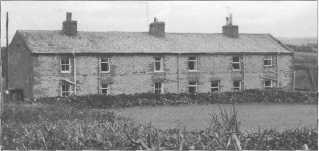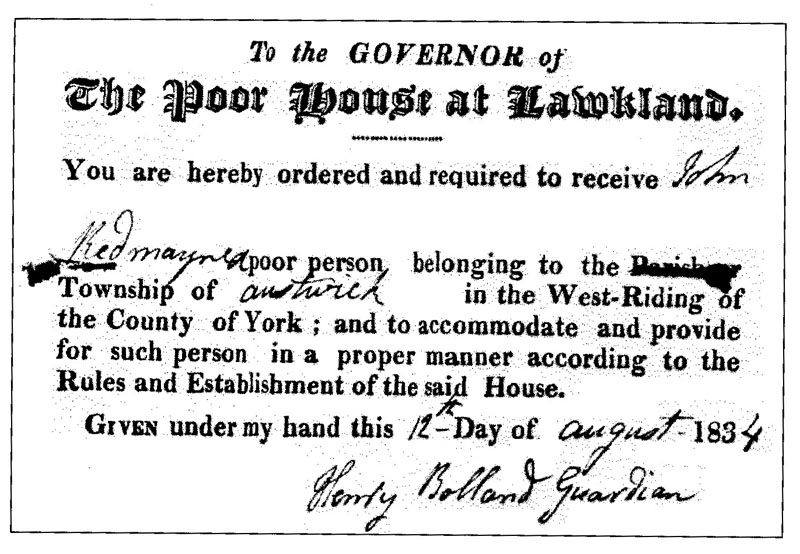| JOURNAL 1999 |
| North Craven Heritage Trust |

J1999p1_9_files/tmpBF8-7.jpg
Lawkland Poor House
Photograph: Roy Gudgeon
J1999p10_19_files/tmpD0B-1.jpg
Copy of Authority given to Governor of the
Poor House, Lawkland
As people drive through the quiet lanes around Settle, and in particular around Lawkland, they will pass by a row of cottages set at right angles to the road, and will be completely unaware as to the happenings at this site some 160 to 170 years ago.
In the 1820's life in the country was hard and difficult, the Napoleonic wars had taken their toll on the country's men and finances, leaving those at home in many instances in dire straights.
At around this time the better off folk in Lawkland decided that their own Poor House, and most Parishes had one, was in need of much attention, and decided that the old thatched Poor House be demolished and a new one built on adjoining land. At that time it was the responsibility of each Parish to look after the needs of their own poor people, and usually to obtain relief the needy had to prove a connection with that Parish and be accepted by the Overseers.
Consequently the Overseers of Lawkland requested quotations for the building, and found it 'scandalous' that the best quotation was for four hundred pounds. After much discussion they decided to instruct their own builders, and in due course the building was completed for a sum almost half the original quotation.
The advent of a new Poor House, raised interest locally, and it was part of the plan to accept residents from other Parishes on the strict understanding that their particular Parish footed the bill! In 1823 the building was completed and apart from the poor of Lawkland, residents were received on a regular basis from Austwick, Giggleswick, Horton, Rathmell, Stainforth and Settle.
A Governor and Governess were appointed, and proper arrangements were made for the maintenance of the Poor House, with a 'VISITOR' appointed who would look after the inmates' welfare, and a 'SURGEON', Thomas Robinson from Settle, was appointed who had to attend the Poor House at least once a month, for five guineas a year, and the Overseers were generally in charge of the whole operation.
The finances for the day to day costs were met by the local residents, hence the reluctance to accept poor people from outside the Parish, unless their expenses were paid by their own Parish. From reading books by Charles Dickens or Emily Bronte, one tends to feel that the Work Houses or Poor Houses, were extremely harsh institutions, but though they were possibly so in the cities, I like to think that at Lawkland conditions may have been austere, but not so desperate as Oliver Twist experienced in his time.
Fortunately most of the records for the Lawkland Poor House, have been retained, and it is possible to picture the life of the inmates whilst they were staying there. Surprisingly, the balance between males and females was almost equal, showing that it was not the practice to split families, and indeed this fact is borne out by an examination of the admissions book.
The food was wholesome though basic, and an extract from the Poor House's record states that "The Governor of the Poor House to choose any cut of beef he thinks, except the hind quarter and crop, and to every twenty pounds of beef to have two pounds of suet at the same price, and take only loins, breasts and necks of mutton". The local butcher at the time was Edward Harrison who supplied the Poor House until it closed in 1837. Meal and flour, like the arrangements for meat, was arranged under a fixed contract, and Thomas Barrett, Richard Baynes, William Baynes and Henry Bolland were successful in tendering offers.
Unfortunately it is not possible to know the precise arrangements for the accommodation at the Poor House, but I do not think it would have been particularly overcrowded most of the time, though on peak occasions space must have been limited! From an examination of the admissions register we can see that the average daily occupancy rate was almost 19 people, during the whole of the life of the Poor House from 1823 until 1837.
However a closer examination reveals that at times the numbers were much higher, and indeed the highest number staying there on any one night was 55
